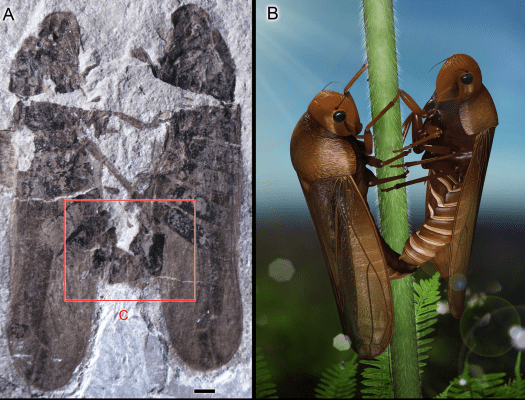
Fossils that capture a kinetic moment are truly fascinating because they surprise a scene or picture from millions of years ago, effectively acting as a time capsule. Paleontologists have found along the years all sorts of such scenes, be them dinosaurs engaged in battle before an unlikely event engulfed and preserved them or some other preservation in the heat of action. Some capture some weird and intimate stances too. For instance, in northeaster China researchers have found an unlikely fossil: two insects fully engaged in mating. Since its 165 million years old, this makes it the oldest record of insect sex so far.
The insects in question are froghoppers, a group of insect species still alive today. After closely studying the fossils, the researchers were able to determine the insects’ genitalia and mating habits have remained largely unchained since the Middle Jurassic. So, yeah, there’s actually an added scientific bonus to studying insect porn. Jokes aside, these insights are really valuable to entomologists who study modern insect species and paleontologists alike.
As far as mating is concerned, it very difficult to determine the extent of both mating organs and behavior millions of years ago. Fossils that trap ancient beings in close moments such as these, though very few in number, are thus very valuable.

Froghoppers get their name from their formidable ability to jump from plant to plant; some species can jump up to 70 cm vertically: a more impressive performance relative to body weight than fleas. The froghopper can accelerate at 4,000 m/s2 over 2mm as it jumps (experiencing over 400 gs of acceleration). There are some 20,000 species of froghoppers, and are best known to farmers who consider them as pests. They’re also known as spittlebugs because their nymphs are covered in … spit. This secretion is activated by moving or pumping their bodies. Once the bubbles have formed, spittlebugs use their hind legs to cover themselves with the froth. The ‘spittle’ serves multiple purposes.
- It shields the spittlebugs from predators
- It insulates them from temperature extremes
- It prevents the spittlebugs from dehydrating
The study, elegantly titled “Forever Love: The Hitherto Earliest Record of Copulating Insects from the Middle Jurassic of China,” was published in the journal PLOS ONE.
Was this helpful?



